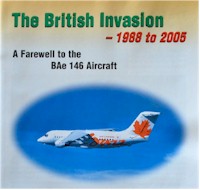This is the conclusion of the story in NetLetter nr 1333 regarding the DC-8 article -
The new owners, IAL Inc, delivered July 10th, 1979, registered as N8021V get, along with a C of A, some 10 cartons of records weighing 500 pounds. These are the job tickets for all the checks and work done on the aircraft. Should they want more information, it's tucked away in the archives for another two years. Of course, the log book, the aircraft's pedigree, is completed from day one. and it goes along with the plane.
Well, she's going now! She was still earning her keep by being leased out to various airlines before being WFU and stored at Smyrna, Tennesse during 1981 and was finally broken up in 1983. Now when the B747's and L-1011`s streak into the sky, she can sit on the tarmac with the knowledge that the first commercial jet to intestinally pierce the sound barrier was a DC-8-43 with Rolls Royce Conway engines. Prior to delivery to CPA, no jumbo had ever done that.
In NetLetter nr 1326, in "Wayne's Wings", Wayne had an article regarding the L-1011. We went back to NetLetter nr 1316, where we had this article originally from Bill Norberg -
The tragic loss of the DC-8 in YYZ in 1970 due to inadvertent deployment of ground spoilers in flight was to have repercussions when it was time for the MOT to provide type certification for the L-1011 in Canada. The MOT was very concerned about what had happened to the DC-8 and were determined to use the power of their office to bring about whatever was necessary to prevent future such incidents. We had a number of meetings with our technical specialists and theirs to discuss what could or should be done. The matter, as we saw it, was one of adherence to established and approved procedures rather than an interlock or mechanical method to prevent such deployment.
One could take their thinking to such actions as fuel shut-off valves or even shutting down engines in flight. Those actions are often necessary but no one would intentionally use them in an inappropriate manner. In any event their concern was raised when they learned that the use of ground spoilers in flight was a fundamental part of the auto approach system of the L-1011. It was called "Direct Lift Control" or DLC and was a method by which the aircraft in an auto approach configuration was maintained on the correct glide slope.
Normally this action was carried out by the autopilot where any deviation from the proper glide slope sent a signal to the autopilot elevator servo to apply a corrective action and restore the aircraft to the correct position. This tended to make an aircraft "porpoise" or hunt somewhat about the proper glide slope angle. In the DLC system the ground spoilers were deployed to a 10 degree angle before engaging the auto approach system. Any deviation from the proper glide slope now fed a signal to the ground spoiler actuator and either increased or decreased the ground spoiler angle. As the ground spoiler angle increased the wing lost some lift... as it decreased it increased wing lift. This had the effect of moving the aircraft vertically up or down rather than in a cyclic hunting fashion. This tended to keep the aircraft tightly coupled to the glide slope with minimum hunting action. It was a great system.
The MOT were not convinced and we had to take a number of their key people to the Lockheed plant at Palmdale California for a test flight and demonstrations by the Lockheed staff. We used the L-1011 aircraft being used for certification tests by Lockheed. It was equipped with extensive instrumentation as well as water tanks throughout the cabin to permit testing at various C of G configurations. There were only seats at the front of the aircraft for about 10 people. It also had an escape chute from the cockpit area down through one of the lower cargo doors which could be activated under emergency conditions. We were each assigned a parachute and given instructions about how to exit. It was a fascinating flight and the MOT staff were given an excellent demonstration of the DLC system and its capabilities. Our problems were over as far as certification were concerned. It was interesting to note that during that flight the aircraft flew in excess of Mach .9 for the first time as well.
 Under "Wayne's Wings" in NetLetter nr 1330, Wayne gave some information regarding the British Aerospace 146 (BAe 146) airliner. We have this booklet which may be of interest. (Click on image to view)
Under "Wayne's Wings" in NetLetter nr 1330, Wayne gave some information regarding the British Aerospace 146 (BAe 146) airliner. We have this booklet which may be of interest. (Click on image to view)
